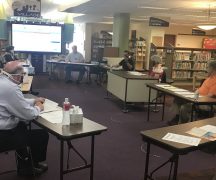Dear School Board, Superintendent Scruci, Principals Dever, Radabaugh, Kellough, Daney, and Karaffa,
I am writing on behalf of a group of parents concerned about the transition to 5-day in-person classes. To give an idea of the numbers of parents our group represents, please recall our previous petition about remote synchronous instruction with over 100 signatures. With the increased densities of students that 5-day in-person schooling would entail, we are worried about meeting the minimum guidance for safe schools from the CDC (https://www.cdc.gov/coronavirus/2019-ncov/community/schools-childcare/schools.html). We would like answers to the following questions within one week of this email. For each building in the district, we would like to know:
- We understand that the decision has been made to use the AAP recommendation of 3 foot distancing rather than the CDC recommendation of 6 feet. However, are there any locations where there will be less than 3 feet of distance? In such situations, will a positive case result in quarantine for nearby students?
- When students are in cafeterias, without masks, while eating, what distance will be maintained? Would a positive case result in quarantine in those environments? Could outdoor tents be used for lunches?
- How will adequate disinfection and cleaning be accomplished without a day set aside for this?
- How will proper ventilation be maintained? In particular, below we have pasted the ventilation recommendations from the CDC (https://www.cdc.gov/coronavirus/2019-ncov/community/schools-childcare/schools.html. We would like to know the approximate percentage of rooms within each building that will achieve each of the following:
- “Increase outdoor air ventilation, using caution in highly polluted areas.
- When weather conditions allow, increase fresh outdoor air by opening windows and doors. Do not open windows and doors if doing so poses a safety or health risk (e.g., risk of falling, triggering asthma symptoms) to children using the facility.
- Use child-safe fans to increase the effectiveness of open windows. Position fans securely and carefully in or near windows so as not to induce potentially contaminated airflow directly from one person over another (strategic fan placement to help draw fresh air into the classroom from open windows or to blow air from the classroom out open windows).
- Decrease occupancy in areas where outdoor ventilation cannot be increased.
- Ensure ventilation systems operate properly and provide acceptable indoor air quality for the current occupancy level for each space.
- Increase total airflow supply to occupied spaces, when possible.
- Disable demand-controlled ventilation (DCV) controls that reduce air supply based on occupancy or temperature during occupied hours.
- Further open minimum outdoor air dampers to reduce or eliminate HVAC air recirculation. In mild weather, this will not affect thermal comfort or humidity. However, this may be difficult to do in cold, hot, or humid weather.
- Improve central air filtration:
- Increase air filtration to as high as possible without significantly diminishing design airflow.
- Inspect filter housing and racks to ensure appropriate filter fit and check for ways to minimize filter bypass
- Check filters to ensure they are within service life and appropriately installed.
- Consider running the HVAC system at maximum outside airflow for 2 hours before and after the school is occupied.
- Ensure restroom exhaust fans are functional and operating at full capacity when the school is occupied.
- Inspect and maintain local exhaust ventilation in areas such as restrooms, kitchens, cooking areas, etc.
- Use portable high-efficiency particulate air (HEPA) fan/filtration systems to help enhance air cleaning (especially in higher risk areas such as the nurse’s office).
- Generate clean-to-less-clean air movement by re-evaluating the positioning of supply and exhaust air diffusers and/or dampers (especially in higher risk areas such as the nurse’s office).
- Consider using ultraviolet germicidal irradiation (UVGI) as a supplement to help inactivate the virus that causes COVID-19, especially if options for increasing room ventilation are limited.
- Ventilation considerations are also important on school buses.”
- “Increase outdoor air ventilation, using caution in highly polluted areas.
- How will parents be informed about what ventilation improvements have been implemented in the specific rooms where their child spends significant time?
- If proper ventilation cannot be maintained in some rooms, can use of these rooms be avoided? If these rooms are used, will everyone in them be quarantined if there is a positive case?
- Even in classrooms where some of the ventilation recommendations above are already being implemented, additional ventilation improvements are possible. We would like to know the plans for improving ventilation in those rooms.
We thank you for your response.
Best,
Kevin and Noel McCluney, Jason Whitfield and Claire Silverman, Sandra Faulkner, Joshua Atkinson, Mitch and Polly Miller, Missy Stanton, Sherrie Hay-Sparks, Emily Anzicek, and Ambre and Matt Partin
On Behalf of Concerned BGCS Parents




